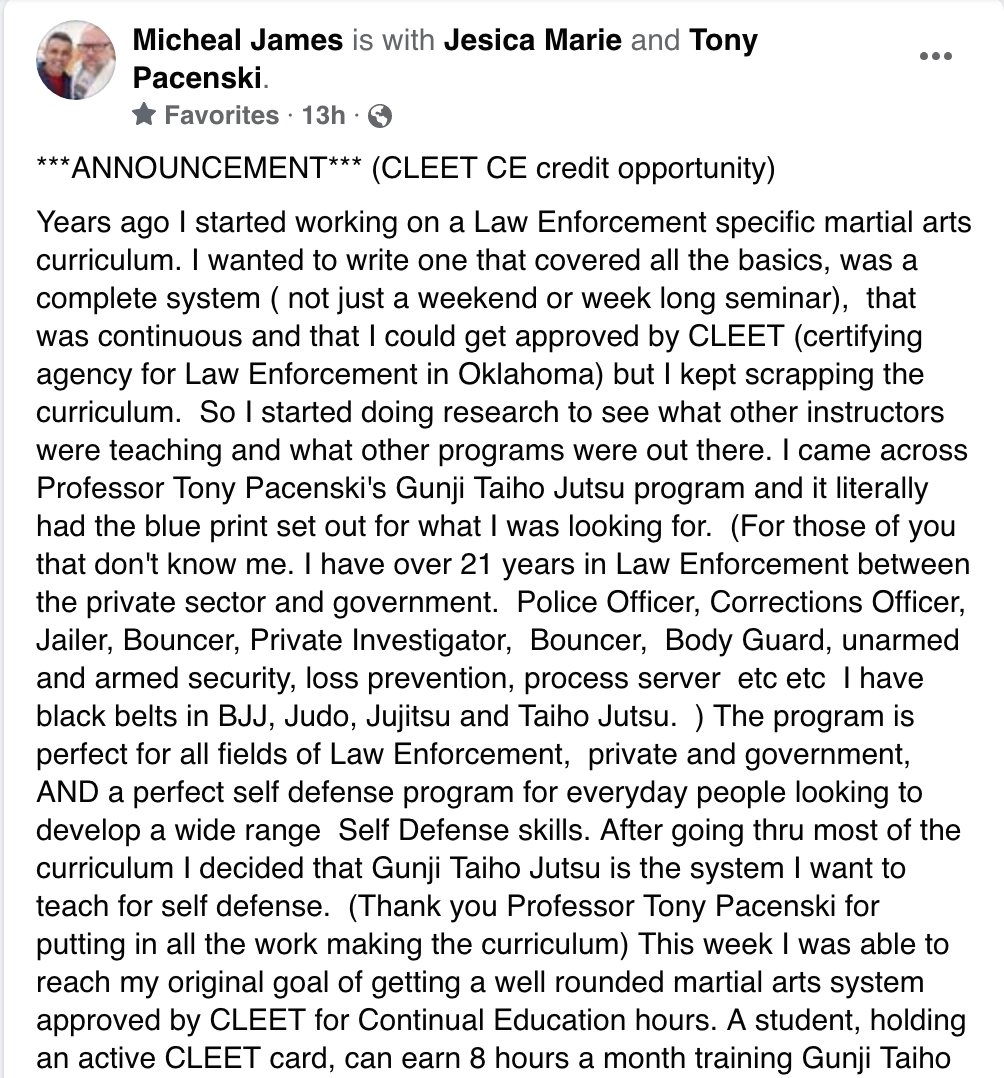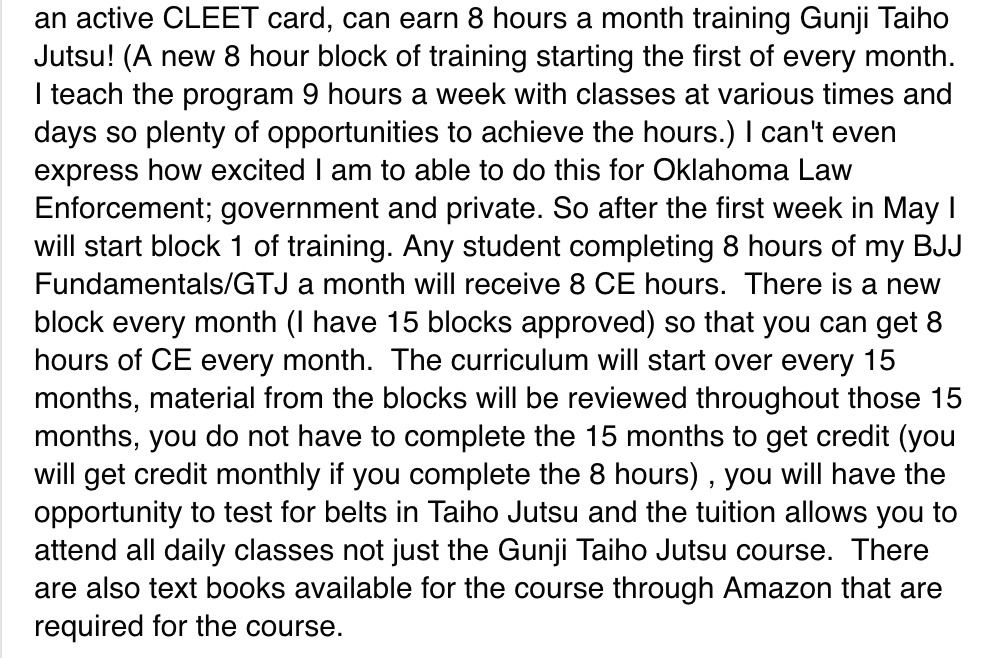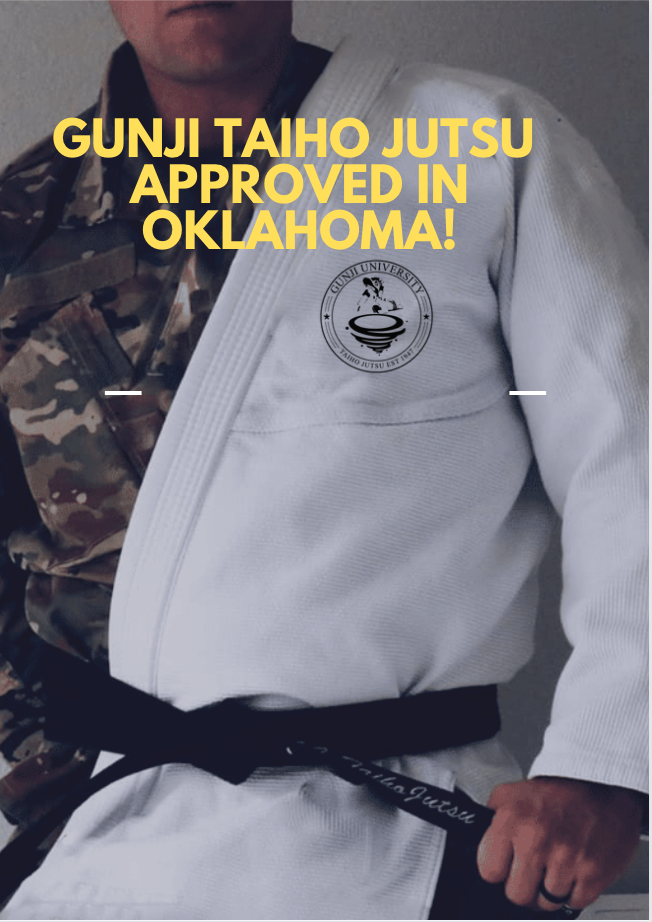2-on-1 Subject Restraint | Championed by Gunji Taiho Jutsu Since 2019 called PAT for Partner Arrest Technique

In October 2016, Total Air Force Combatives - Striking - Grappling - Weaponry Arts was published as my first attempt at developing a Combatives manual for the United States Air Force. At that time, I was stationed at MacDill AFB in Tampa, Florida, and Security Forces were seeking techniques specifically for arresting. By June 2019, Gunji Taiho Jutsu, a system of arresting techniques for Security Forces and Law Enforcement, was introduced with a full manual, video curriculum, and online instructor training course available at www.GunjiUniversity.com.
At www.gunjiuniversity.com, in weeks 11 and 13, the written manual, video instructionals, and curriculums cover Partner Arrest Techniques, known as PAT strategies in Gunji Taiho Jutsu. In week 11, members are taught how to cooperate in a two-on-one arresting situation, emphasizing safety for all parties involved under the PCS 3 concept. In week 12, leg control for PAT strategies, including arm-leg lacing and figure-four holds, is covered. ...
2˚ Degree Black Belt Instructor Leveling Up

This is how you level up to 2˚ Degree Black Belt in Gunji Taiho Jutsu (GTJ). Congratulations to Micheal James Rosequist on his promotion in Gunji Taiho Jutsu . It was truly a team effort to bring together individuals from different time zones, ensuring the video feed was clear and understandable, and putting in a lot of work before the final evaluation today. Micheal’s understanding and application of the instructions learned from the certified instructor training through Gunji University were excellent. I was most pleased with the results and seeing the concepts and pedagogies in action. Therefore, Micheal earned the Gunji Taiho Jutsu Senior Instructor 2°. Additionally, the Yūdansha is also in order due to is application of the GTJ katas. All in all, I am proud to see Micheal embody and put into application the Gunji Taiho Jutsu system.



If you want to become a certified Black Belt GTJ Instructor, below are the steps:
1: You need to complete the student curriculu...
Gunji Taiho Jutsu Releases for the 1st Time Ever Katas for Taiho Jutsu | New Course | New Book
Gunji University is excited to finally announce the release of the Gunji Jutsu Taiho official katas: Ichi-No-Kata & Kaiten-Katame-No-Kata. Currently, students can enroll in the GTJ Kata course and work through a self-paced curriculum of 16 video lessons that break down each form and read through the 200+ textbook Volume 6 - Gunji Taiho Jutsu Official Katas. The Kata course provides an e-book version of the textbook, or students can purchase the physical book through Amazon.com. See the admission link above.
It should be noted that if a Gunji Taiho Jutsu student successfully passes a GJT Kata testing of both Ichi-No-Kata and Kaiten-Katame-No-Katas, as the Tori, these evaluations will meet the requirements to earn a Gunji Taiho Jutsu Yūdansha certification. Yūdansha means one that holds a dan rank. If you have completed all of the student curriculum material and wish to be evaluated by a Gunji Taiho Jutsu instructor online through Gunji University, please contact Tony Pacenski. In a...
The Discoveries of Taizan Ryu Taiho Jutsu and the Systems of Soke Joseph Miller

In typical fashion, just when you believe paths will not cross, I finally met Soke Joseph Miller (Retired Air Force) last week. I had been trying to find Soke Miller for some two years now in Japan, and on that day introduced myself and physically took the food basket out of his hands so we could shake hands. We could discuss Martial Arts, Budo, and Taiho Jutsu (arresting technique). Specifically, we got into Hakko Ryu Jujutsu, Yoshitsune Jujutsu, and Taizan Ryu Taiho Jutsu.
After departing, I got invited to the Taizan Ryu Dojo in Japan. At the time of this writing, I am now reflecting on the first of many more training sessions I received last night; before exploring the content of last night's training, it is crucial to understand who Soke Joseph Miller is and his experience with Soke Ryuho Okuyama, founder of the Hakko Ryu Jujutsu. There is a connection between Soke Okuyama, Soke Miller, and Gunji Taiho Jutsu.
Last night Soke Miller gave me the platform to let the students and i...
The Official Katas of Gunji Taiho Jutsu
Gunji Taiho Jutsu has two formal Katas at the time of this writing. The motivation to create forms 1. Ichi-No-Kata (To Position Oneself) and 2. Kaiten-Katame-No-Kata ( To Grapple With Rotation) have come to design through my Kata training at the Kodokan in Tokyo. Each month the Judo tatamis on the top floor of the Kodokan allow students to practice many of the official katas of Judo under the instruction and watchful eyes of the senseis. I have been able to pick up the necessary details and improve my practice of Nage-No-Kata and Katame-No-Kata by participating in these training sessions. At the same time, I have observed practitioners and senseis practicing Kime-No-Kata, Kodokan Goshin Jitsu, Ju-No-Kata, and additional katas of Judo, gaining incredible insights into Japanese culture, budo etiquette, and protocols.

These official katas at the Kodokan have assisted the art of Judo spread worldwide and had a stable base of knowledge for over 100 years. For this reason, I want...
Understanding Nishio's Half-Step Can Lead The Way

Practicing Japanese Martial Arts in Japan for the last two years has allowed me to learn more about Judo, Kendo, and Aikido. Within Aikido, I was first attracted to comprehend the Aikikai style as there are today many different variations of Aikido. The founder of Aikido, Morihei Ueshiba, had many live-in students over the years, and one was Yasuo Kobayashi Sensei, who is today an 8th dan in Aikido. I could write several articles about Kobayashi Sensei because of my unique experiences in this dojo learning the Aikikai style, much about taiho jutsu, the jo staff (aikijo), the bokken (aikiken), and among other disciplines like Japanese calligraphy after classes on Saturdays. During the era of Covid-19, I was not able to travel a lot east into central Tokyo, where Ichiro Shishiya Sensei was teaching; however, this would change in 2022. So for 2021, it was a deep dive into the Aikikai approach to Aikido with Kobayashi Sensei.
(Shoji Nishio practicing Judo in 1950 at the Kodokan in Toky...
ANNOUNCEMENT: Gunji Taiho Jutsu Approved In Oklahoma
Gunji University wants to congratulate Michael James Rosenquist of Gorilla Judo And BJJ Club- Ricardo Calavanti Oklahoma for successfully getting Gunji Taiho Jutsu approved by the Certifying Agency of Law Enforcement in Oklahoma (CLEET) for continued education hours. What this means in more first-responders will be able to earn training hours for completing Gunji Taiho Jutsu training by GTJ certified instructors. Please read Michael's Facebook post below:


Again, much applause and congratulations to Micheal's effort! There is good work to be done.
Next, this puts a higher demand for GTJ Certified Instructors!
‘Teachers have three loves: love of learning, love of learners, and the love of bringing the first two loves together.’–Scott Hayden
To The Reader
The author will be most happy to receive your comments, including criticisms and suggestions. Noteworthy comments may be included in future editions or books on this series.
Citations for Educational Purpose:
Mi...
Teaching with the Heart of a Teacher and Not of a Salesman
The art of teaching is unique. As much as a person can say it is a science and a method, it is not. Teaching is an art, and from the beginning to the end a teacher has to have heart. He or she needs to be able to have the teacher's heart; not a salesman's heart. People will see through a salesman's pitch to buy; however, a teacher's heart comes through different to a person wanting to learn how to do something better or desiring to reach a long-term goal.
People come to you when you are the teacher from different starting points. From my point of view if I can help someone, I am will do it and I want the lesson to be powerful. Something he or she will remember even if they never do it again. In the context of Martial Arts, Combatives or Taiho Jutsu, if the person learns something that I can share, I want the person to walk away knowing "that stuff works." The person becomes the marketing and the salesman of a great teacher whose heart is in the right place...for the student.
Video ...
The Finer Points of the Police Armbar 1 (Ikkyo/ikkjo)

In Gunji Taiho Jutsu (GJT), before a student is ever taught a technique to bring a person to the ground to finalize an arrest strategy, he or she must learn GTJ PCS strategies 1 and 2. With PCS 1 there is an ability to approach a suspect to observe the proximity, gain compliance and see how the suspect is standing. PCS 2 looks at the officer's positioning, control, and system of takedown against the suspect. These two guiding principles of GTJ give the officer the opportunity to transition next to GJT PCS 3: Pinning, Communication, and Safety for all. Altogether this form of taiho jutsu instruction is much better and useful to the student instead of learning a bunch of isolated techniques or "police holds" such as the armbar.
In many police academies and law enforcement training blocks, trainees are taught from the side position standing to use the armbar. This is a straight armlock of control that can be used effectively to bring a suspect to the ground. For GTJ, again, the straight ...
Turning Uke's Hand | Kote Gaeshi's Spiral Leverage

For almost a year living in Japan, I have been studying how to off-balance my training partners that I am throwing (Uke's). Off-balance or breaking a person's balance is called Kuzushi. I have been training Karate, Judo and Aikido while all this time catching some great moments in my learning curve on this topic. This has assisted in my research of evolving taiho jutsu arresting technique and specifically something of value to add to the Gunji Taiho Jutsu system.
One of the key positioning points or objectives to reach in Gunji Taiho Jutsu is the outside position (outside line). This is the point just next to your training partner or someone that you wish to bring to the ground to arrest. From the outside line, it to easy to gain the back position which is even better in terms of superior positioning to protect yourself from a bigger and stronger person. In former blogs, I have discussed the universal arm control with two hands-on holding a person's one arm. This universal arm control...




